© 2010-2021 by Fine Arts of the Southwest, Inc. All rights reserved.
Unauthorized reproduction or use is strictly prohibited by law.
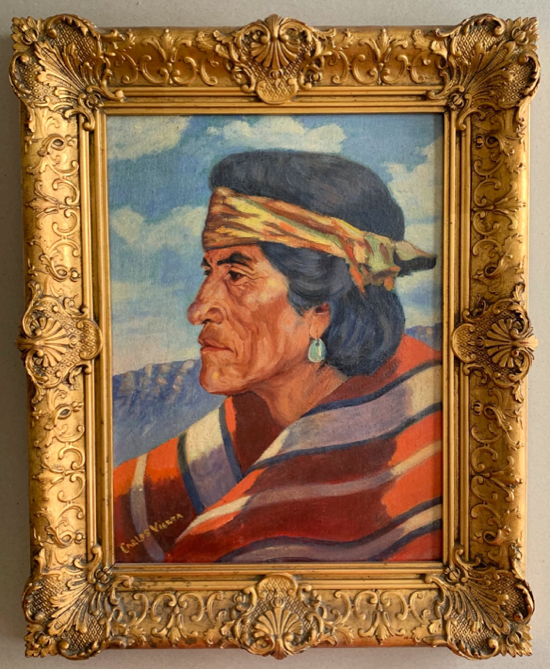
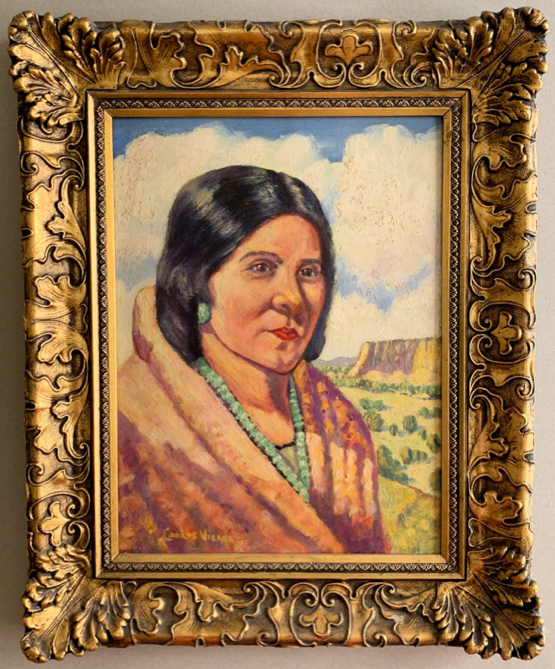
An extraordinary matched pair of original oil on artist’s board portraits of an unknown Acoma Pueblo Indian man
and woman by Santa Fe artist, Carlos Vierra, c.1915-25
Introduction
These paintings are an extraordinary and interesting pair and more than a bit of an intriguing Southwestern mystery story spanning a hundred years. Unfortunately, the great Southwestern mystery writer Tony Hillerman is no longer with us to help us figure it all out. The paintings are the product of a unique combination of unique individuals and a unique place in a unique time; an extraordinary painter and devoted architectural preservationist, two extraordinary Native subjects and an extraordinary and exotic place which happens to be one of the oldest continuously inhabited places in North America, the Acoma Indian Pueblo in West-central New Mexico.
First of all, is the artist. This matched pair of beautifully done formal academic-style portraits were painted around1915-1925 by the prominent California-born son of a Portuguese sailor, painter, photographer and architectural preservationist, Carlos Vierra (1876-1937). Vierra was the very first Anglo artist to set up shop in Santa Fe around 1904 and he is considered along with fellow painter Warren E. Rollins (1861-1962) to be an important founder and key member of the Santa Fe Art Colony. In 1912, the first year of New Mexico’s statehood, several of Santa Fe’s civic leaders, including Museum of New Mexico Director Edgar Lee Hewett, archaeologist Sylvanus G. Morley and Carlos Vierra, formed the city’s first Planning Board to oversee the realms of historic preservation, town planning and revival architecture. Vierra was a major source of information about the architecture of New Mexico and a primary collaborator in the preservation design process for The San Estevan del Rey church at Acoma Pueblo in the 1920’s.
Carlos Vierra
In addition to being a talented painter and photographer Carlos Vierra was a knowledgable architectural preservationist and a dedicated, tireless city planner. Santa Fe
owes much of its historic appearance and architectural authenticity today to Vierra’s vigorous efforts. At left above, is the La Fonda Hotel completed and later remodeled in
the 1920’s and at right is The New Mexico Museum of Fine Arts of 1917, both of which were designed and built in the “Pueblo Revival” style of architecture Vierra was influential in establishing and promoting. The appearance and design of the museum’s cathedral auditorium owes a considerable amount to the San Estevan del Rey Mission church at
Acoma Pueblo which Vierra played a key role in preserving.
-Photo source at left and right, Farona Konopak, The Fred Harvey Company.
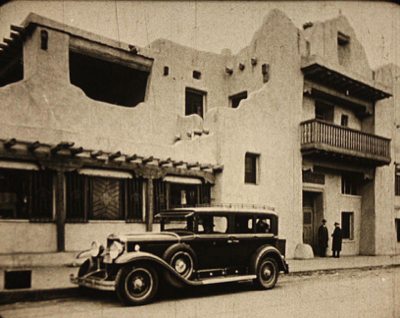
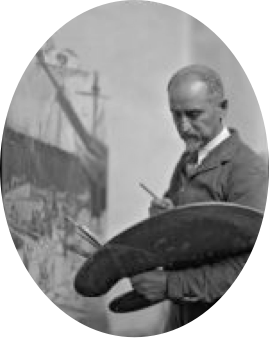
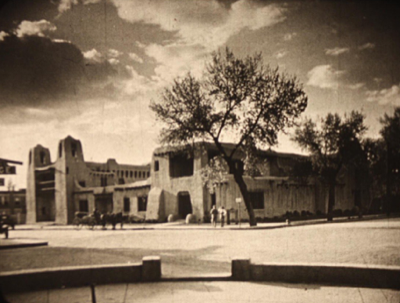
“It was Vierra's insistence upon purity of style that saved Santa Fe from many an architectural monstrosity... Up to the time of his death he guarded the integrity of the Pueblo and Spanish colonial architecture with a zeal often leading to heated controversy. That Santa Fe is not only a "City Different" but also a "City Beautiful" is more largely owing to him, perhaps, than to any other one individual.”
-Quotation source and © Historic Santa Fe Foundation
Next to consider here are the handsome male and female subjects of these portraits; an unknown pair of Acoma Pueblo, New Mexico native people, the man is very clearly a Native American, the woman appears to possibly have some European features and wardrobe and is perhaps part Pueblo and part European or possibly all European or even all Pueblo as the inscription “Acoma Woman” on the back of the painting seems to indicate.
So this is where all the questions begin. Whoever are these people from this extremely remote and secretive
(especially in the 1910’s) deeply historic tiny Acoma Indian Pueblo way out there in the high mesa hinterland of West-central New Mexico that a prominent Santa Fe painter such as Carlos Vierra painted a pair of formal European-style portraits of them? It’s a completely improbable, almost totally foreign cross-cultural situation to consider.
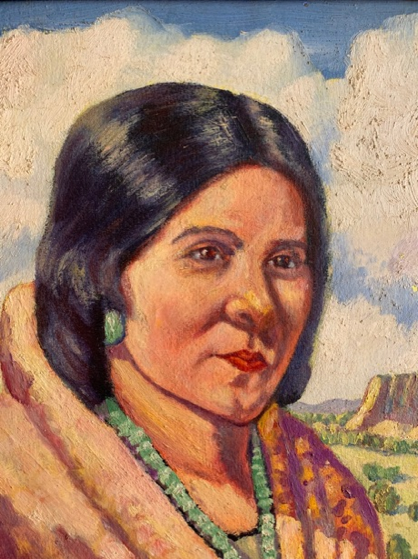
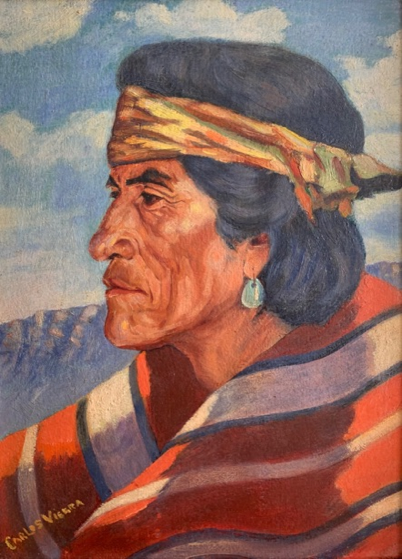
It is most likely that the idea of painting these portraits came from Vierra himself as the historian and cultural preservationist he was. He might have asked the people to allow him to paint them for posterity or possibly photographed them on one of his many visits to the Acoma Pueblo to paint them later back at his Santa Fe studio.
Their political or social prominence or family relationships likely played a role in this, he didn’t just paint them happenstance because he liked their appearance.
We will explore this further shortly, but add to the growing mystery the fact that the paintings are very finely and most elaborately framed in original period extremely fancy, extremely expensive custom made European style gilded frames handmade by the exclusive Newcomb-Macklin company of New York and Chicago, at that time the most exclusive and costly custom framemakers in the world—the Rolls-Royce of picture framing if you will. Every Southwestern artist worth their paintbrush wanted their paintings framed in Newcomb-Macklin frames, but few were ever able to afford it.
Now add to all that the fact that the paintings are both prominently stenciled on their versos with the notation “Biltmore Hotel”. So at this point the story now involves Acoma, Santa Fe and now New York City and thus grows more mysterious by the moment. And then the final cherry on the top of this sundae of weirdness, the paintings came to us from a family in the tiny town of Antonito in far southern Colorado (Population 753) just a few miles north of the New Mexico border where they had been for decades and the family who sold them said that they knew nothing at all about them. How in God’s name, after their long and unlikely journey from Acoma or Santa Fe to New York City and back out West, did these paintings end up in the remote little Hispanic farming community of Antonito, Colorado?
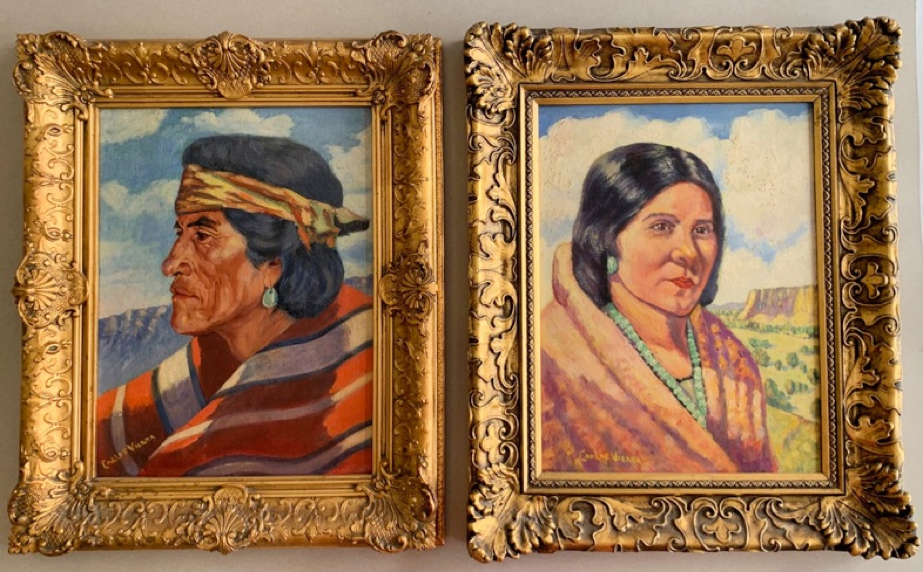
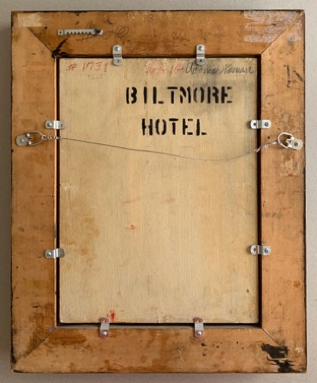
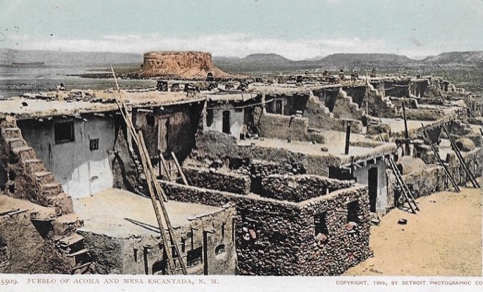
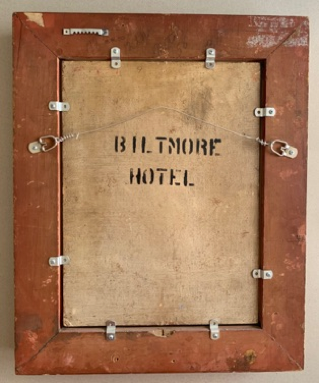
Vintage postcard view of Acoma Pueblo and Enchanted Mesa, c. 1900.
Photo source and © Detroit Photographic Co.
The Paintings
These beautiful original portraits are very finely and precisely painted in oil on artist’s Board. The paintings each measure 16” by 12” and they are most elaborately framed in original period European-style hand-carved gold gilded frames custom made for them by the renowned Newcomb-Macklin Company of Chicago and New York. The framed dimensions of the paintings are approximately 21 1/2” by 17 1/2”.
In consultation with our distinguished colleague, the late Steven L. Rose, former owner of Los Angeles’ and Scottsdale’s famed Biltmore Galleries and one of the world’s leading authorities on historic Western American art, we determined that these paintings were once the property of the renowned Biltmore Hotel on 42nd Street in New York City which housed the very prominent Grand Central Galleries where the work of Carlos Vierra and many other well-known and accomplished Taos, Santa Fe and other Western painters was represented. Mr. Rose believed that the paintings were most likely purchased by The Biltmore Hotel from the Grand Central Galleries as evidenced by the prominent “Biltmore Hotel” prominently stenciled in black paint on their versos.
The paintings are very beautifully done, the brushwork is very well-executed and particularly sensitive and expressive and the color palette is rich and vibrant. The paintings are in remarkably excellent original condition, looking essentially fresh as a daisy and especially so considering their century plus of age and their improbable journey first from the Southwest to New York City and then back to the Southwest over the years. There are a couple tiny paint chips to each painting, and some minor abrasion in the sky behind the woman's head. The paintings could probably benefit from a professional cleaning and a fresh varnish but we have decided to leave that decision to their next owner. Each painting is properly signed “Carlos Vierra” at the lower left and is stenciled “Biltmore Hotel” in black paint on the verso. The Biltmore Hotel closed in 1981and it is possible these painting were sold from the hotel’s collection then.
Additional interesting information on the painting’s verso is a consecutive set of what appear to be inventory numbers, “1738” and “1739” likely either Vierra’s own or possibly the Biltmore Hotel’s handwritten in red grease pencil. What appears to be the painting’s original, circa 1915-1925 prices of $225.00 each also appears on the verso of each And finally, a stenciled “NM Co” for the Newcomb-Macklin Frame Company appears on the verso of one frame. The paintings are in remarkably excellent original condition especially considering their century plus of age and their improbable journey first from the Southwest to New York City and then back to the Southwest over the years. There are a couple tiny paint chips to each painting, and some minor abrasion in the sky behind the woman's head.

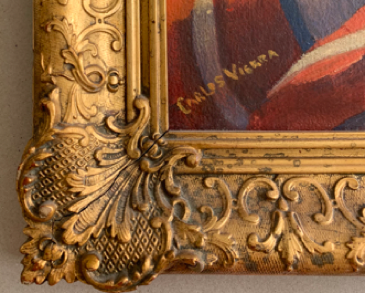
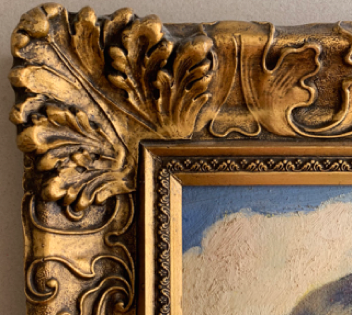
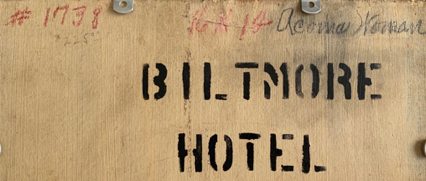
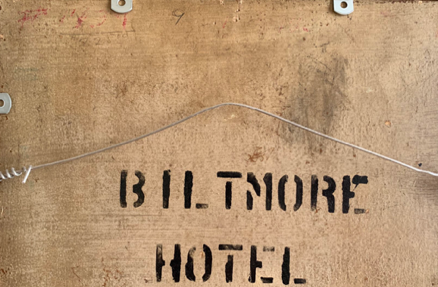
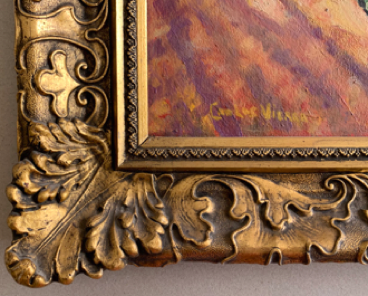
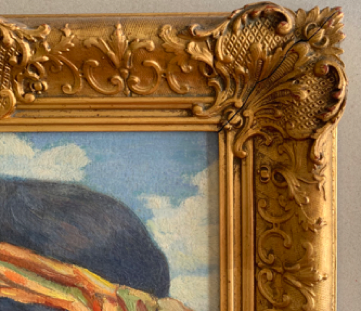
The People Involved
As for who the subjects of the paintings are, we don't know for certain but we do have some very interesting clues.
The woman’s portrait is titled "Acoma Woman" in an old-fashioned heavy pencil cursive lettering on the verso, probably by the artist, even though as we have mentioned previously she looks somewhat European in her facial features, hair and dress. There has been some European blood mixed with the Acomas since the days of the Spanish Entrada and subsequent conquest in the 16th Century. However, there was (and still is) a large extended family of the descendants of Anglo European German-Jewish immigrants, the Bibo family, who moved to New Mexico from Germany in the last several decades of the 19th Century eventually becoming Indian traders first in Santa Fe and then later at Acoma Pueblo and at the nearby Laguna Pueblo.
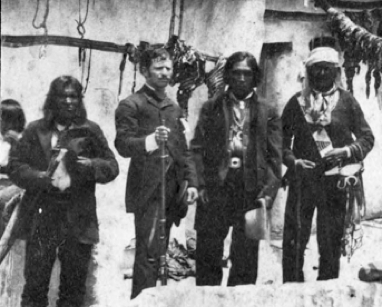
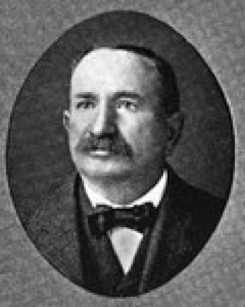
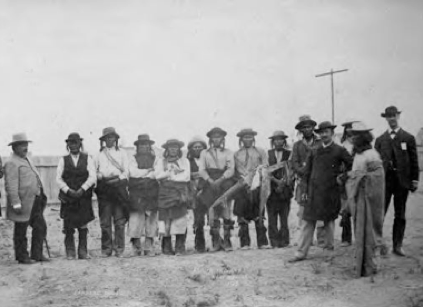
German-born Jewish merchant and Indian trader, Solomon Bibo (1853-1934), is seen in the photo at above left at second from left holding one of the hereditary Acoma Pueblo canes of authority. Bibo is also seen in the center photo and in the photo at right, third from right. Bibo served as the Governor of Acoma Pueblo from 1885 to 1899 where he was known as “Don Solomono”. In 1885, Bibo married Juana Valle, daughter or grand-daughter of the Acoma Pueblo Chief, Martin Valle, which made Bibo an official member of the Acoma Tribe and the only known Jewish Indian Chief in American history.
-Left photo source and © Photo Archives of The Palace of the Governors, Santa Fe,
center photo source and © geni, right photo source and © wikipedia
This historic photo above at center, c. 1885-90, is entitled “Solomon Bibo, The Jewish Indian Chief and Acoma woman”. The Acoma woman in this photo bears a distinct but somewhat younger resemblance to the Acoma woman in the Vierra portrait whom we have good reason to believe might be Juana Valle, the daughter or granddaughter of Acoma Chief, Martin Valle. In 1885, around the time this photo was taken, Juan Valle married Solomon Bibo who had just become the Governor of Acoma. Around 30 to 35 years later, Carlos Vierra painted these portraits.
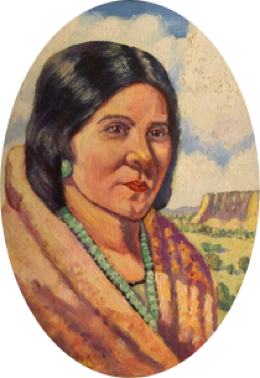
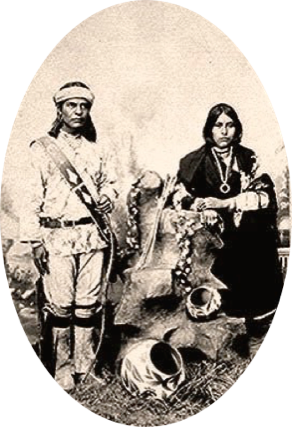
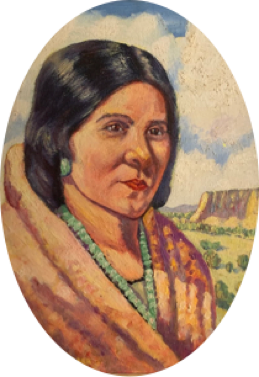
“Solomon Bibo, the son of a Westphalian rabbi, married the daughter of an Indian chief of Pueblo and in later years when he became governor did much to improve the condition of the indians.”
-Oliver LaFarge, “Santa Fe, The Autobiography of a Southwestern town”, University of Oklahoma Press, 1959
One particular member of the Bibo family, Solomon Bibo (1853-1934) is one of the most interesting and unusual characters in the entire modern-day history of the American Southwest. Over the course of his trading activities with the Acoma people and due also to the invaluable assistance he lent to Acoma leaders in conducting land negotiations with the U.S. Government in Washingtom, Solomon Bibo became so well-trusted and liked by the Acoma Pueblo people that in 1885 Bibo actually became the Governor of Acoma Pueblo himself, a position he held for fourteen years.
The woman pictured in the Vierra portrait could possibly be Juana Valle and the man who definitely looks Acoma might be her father or grandfather, the famous Acoma Chief, Martin Valle, who in addition to his years as Acoma Chief and Governor was also close friends with numerous Anglo visitors including Carlos Vierra and the intrepid adventurer and photographer Charles Fletcher Lummis who photographed him and frequently bought things from him on behalf of the Southwest Museum in Pasadena, California. In addition to Martin Valle himself, several other possible candidates for the male portrait’s subject include the later Acoma Governor Lorenzo Lino, the Acoma War Chief, Faustino and prominent Acoma silversmith Juan Lujan, all of whom are pictured below in photos taken at Acoma by Charles Lummis.
It is important to note that in his role as architectural preservationist and Santa Fe City planner, Carlos Vierra devoted a great deal of time to studying and preserving New Mexico’s various historic churches and first and foremost of these was the extraordinary and massive historic 17th Century Spanish Mission church at Acoma Pueblo, San Estevan del Rey, the oldest and largest adobe structure in the United States. Vierra visited Acoma regularly to document and participate in the important restoration of this church directed by the distinguished Santa Fe architect John Gaw Meem in the 1920’s and in this capacity Vierra would have met and had direct personal access to many of the leaders and prominent families at Acoma. Vierra could certainly have requested that they sit for him to be painted or have photographed them and then painted the portraits from his photos at a later time back in his Santa Fe studio.
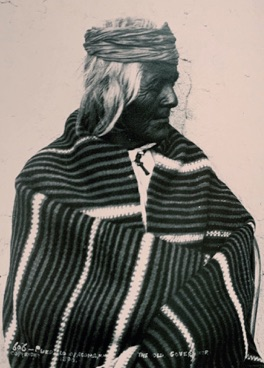
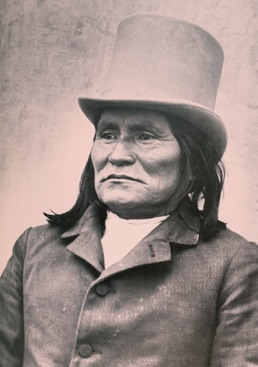
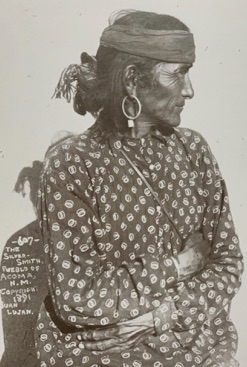
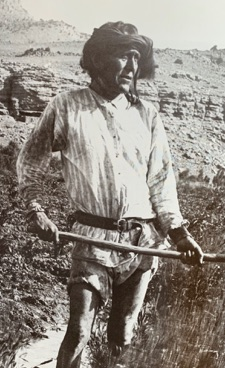
Left to right, Acoma Chief and former Governor, Martin Valle, later Acoma Governor Lorenzo Lino, c. 1902, Acoma silversmith Juan Lujan and Acoma War Chief, Faustino, c. 1902
All images source and © “Lummis in the Pueblos”, by Patrick and Betsy Houlihan, Northland Press, 1986. Charles Fletcher Lummis photos source and © The Southwest Museum, Pasadena, CA

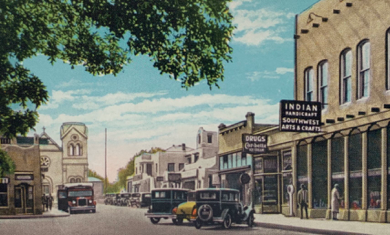
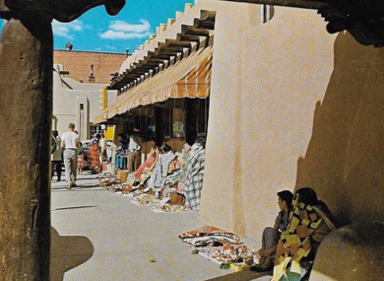
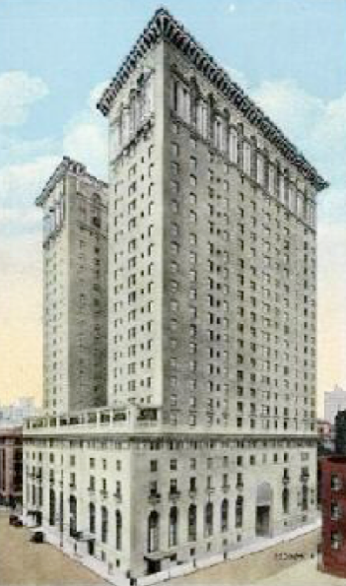
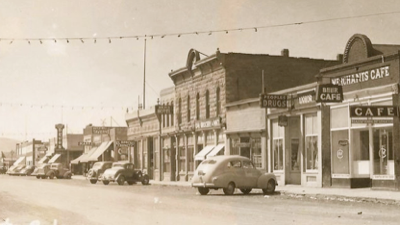
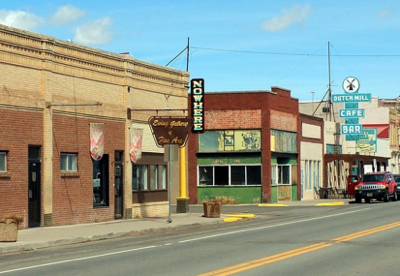
The Journey East and Return West
We know that at some early point in their 100-plus year old lives the paintings which had their initial inspiration at Acoma Pueblo somehow traveled to the prestigious Biltmore Hotel on 42nd Street in New York City. They likely traveled there by buckboard wagon from Carlos Vierra’s studio in Santa Fe to the Santa Fe Railway depot in Lamy, NM some 20 miles south where they boarded the Santa Fe Railway for the long trip east. New York’s Biltmore Hotel beginning in 1913 was home to the prominent Grand Central Art Galleries where the artwork of Carlos Vierra and many other prominent New Mexico and other Western artists was regularly exhibited and sold. How long the paintings remained in New York City is unknown, but the prominent painted Biltmore Hotel stencils on the back of the paintings suggest they were in the hotel’s collection for some period of time possibly even until the hotel’s ultimate closing in 1981.
At an unknown point and in an unknown manner the paintings returned back to the Southwest, possibly with other stops along the way, to the collection of a private family in the tiny Hispanic farming community of Antonito, Colorado where they were eventually purchased by a Santa Fe colleague of ours in 2008 and subsequently purchased by us. The painting’s journey back west from New York City was also likely long and difficult and likely again involved transportation on the Santa Fe Railway back to Lamy and then to Santa Fe and possibly then from Santa Fe directly north to Antonito, Colorado on the regional Cumbres and Toltec “Chile Line” Railroad.
At top, Enchanted Mesa at Acoma, at left, views of Santa Fe, c. 1940‘s, 1980‘s, at center, The Biltmore Hotel on 42nd St. in New York City, at right, Antonito, CO, c. 1930‘s and 1980’s
-Biltmore Hotel photo source and © wikipedia, Antonito photo at upper right source and © pinterest, Antonito photo at lower right source and © wikipedia
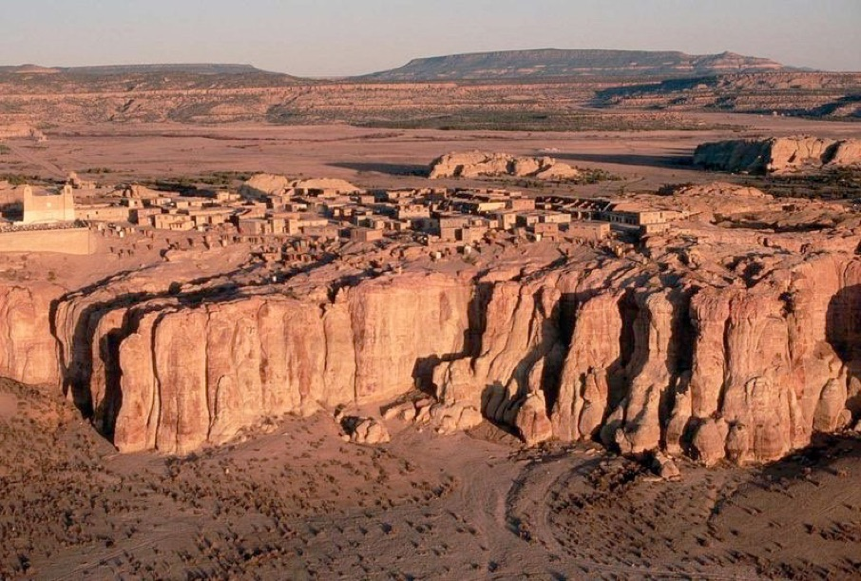
Conclusion
This is an absolutely fascinating detective story and there is still much more left to be discovered, but we certainly
have enough in hand now to know beyond the shadow of a doubt that these paintings are beautiful, rare and unique artistic, historic and cultural treasures and documentations involving an extraordinary cast of characters in and around an extraordinary place, culture and time period. As we previously noted, there is nothing fanciful or accidental about these paintings in our view. Artist Carlos Vierra was a serious, dedicated and meticulous historian of the Southwest region, interested in accurately documenting, recording and preserving its unique history and culture.
These paintings are a deliberate and eloquent attempt to do precisely that with particularly chosen people depicted
in a particular manner and in that they succeed admirably. Collectors, scholars and institutions would be well advised to take note of these extraordinary pieces seriously, they are truly a remarkable American and world treasure trove.
Price available on request. Sold as a pair only.
"One of the strongest places ever seen, because the city was built on a high rock.
The ascent was so difficult that we repented climbing to the top.”
-Francisco Vazquez de Coronado, 1540
Photo source and © Getty Images
Acoma Pueblo
Acoma Pueblo, about 65 miles west of present day Albuquerque, New Mexico lays a legitimate claim to being the oldest continuously inhabited place in the United States, established around 1150 A.D. Acoma Pueblo is an ancient village which plays a pivotal role in the history of the Southwest. Acoma was first seen through European eyes by Francisco Vazquez de Coronado in 1540. A half century later, in January, 1599, another Spanish Conquistador Juan Zaldivar de Onate engaged the Acoma Indians in a brutal three-day battle and subsequent massacre which culminated in numerous atrocities being perpetuated upon the Acoma people; a tragic event that has never been forgotten.
“Acoma Pueblo is built atop a sheer-walled, 367-foot sandstone bluff in a valley
studded with sacred, towering monoliths. Since 1150 A.D., Acoma Pueblo has earned
the reputation as the oldest continuously inhabited community in North America.
The mesa-top settlement is known worldwide for its unique art and rich culture. “
-Quotation source and © Sky City Cultural Center, Acoma Pueblo
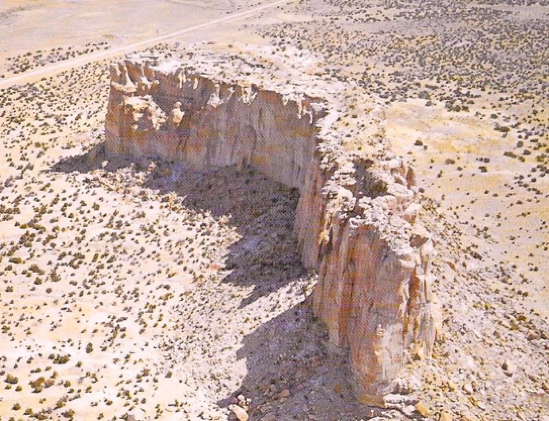
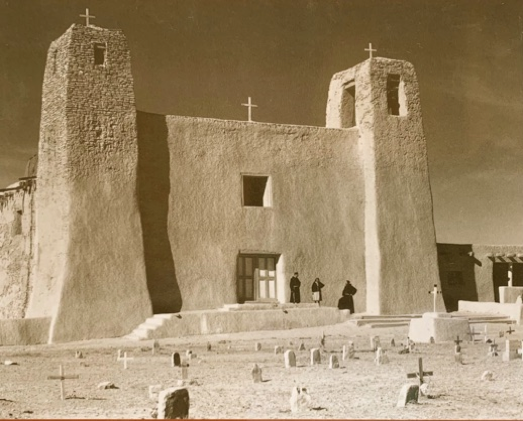
At left, “Katzimo” or Enchanted Mesa, the ancestral home of the Acoma Pueblo people. At right, the San Estevan del Rey Mission Church at Acoma Pueblo which was built between 1629 and 1641 and is the largest and oldest adobe building in the United States. San Estevan del Rey was preserved and restored in the 1920’s by Santa Fe architect, John Gaw Meem in close consultation with artist and preservationist, Carlos Vierra.
Acoma church photo source and © John Gaw Meem at Acoma, Kate Wingert-Playdon, University of New Mexico Press, 2012
“Of all the 19 pueblos of New Mexico, Acoma is by far the most wonderful. Indeed, it is probably the most remarkable city in the world, Perched upon the level summit of a great ‘box’ of rock, whose perpendicular sides are nearly 400 feet high, and reached by some of the dizziest paths over trodden by human feet, the prehistoric tows look far across the wilderness, Its quaint terraced houses of gray adobe, its huge church (hardly less wonderful than tho pyramids of Egypt as a monument of patient toll), its great reservoir in the solid rock, its superb scenery, its romantic history, and the strange customs of its 600 people, all are rife with interest to the few Americans who visit the isolated city. Neither history nor tradition tells us when Acoma, was founded.
The pueblo was once situated on top of the mesa Encantata (enchanted tableland), which rises 700 feet in air near the mesa now occupied. Four hundred years ago or so, a frightful storm swept, away the enormous leaning rock which served no a ladder, and the patient people, who were away at the time, had to build it new city. The present Acoma was an old town when the first European, Coronado, the famous Spanish explorer, saw it in 1540. With that its authentic history begins, strange, weird history. In scattered fragments, for which we must delve among the curious ‘memorials’ of the Spanish conquerors and the scant records of the, heroic, priests. Cubero is the nearest elation to the most ‘wonderful aboriginal city on earth, cliff built, cloud swept, matchless Acoma. Thirteen miles south, up a valley of growing beauty, we came to the home of these strange sky dwellers, a butte of rock nearly 400 feet tall and 70 acres in area.”
-Charles Fletcher Lummis
